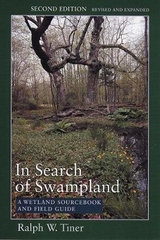
In Search of Swampland
A Wetland Sourcebook and Field Guide
Seiten
1998
Rutgers University Press (Verlag)
978-0-8135-2506-8 (ISBN)
Rutgers University Press (Verlag)
978-0-8135-2506-8 (ISBN)
- Titel erscheint in neuer Auflage
- Artikel merken
Zu diesem Artikel existiert eine Nachauflage
Introduces readers to wetlands and their identification, providing an overview of wetland ecology. The book examines wetland characteristics, formation, functions, values, causes of loss and degeneration and wetland protection. It also provides a guide to wetland plants, soil and animals.
Traditionally, most Americans have viewed natural wetlands as wastelands, places to be drained and converted for farming or filled for housing and industrial development. To date, over half of the country's wetlands that existed when the Pilgrims first landed in America have been destroyed. Today these """"wastelands"""" are beginning to be recognized as one of the world's most valuable natural resources. They are the temperate zone equivalent of rain forests, serving vital life-sustaining functions in water-quality renovation, aquatic ecosystem productivity, and biodiversity, as well as providing benefits such as flood-damage protection and shoreline stabilization. In the revised and expanded edition of this classic guide, Ralph W. Tiner introduces readers to the ecology and beauty of these valuable natural resources. Topics include the formation and functions of wetlands, wetland types, causes of loss and degradation, and recent efforts to protect them. The discussion now includes many examples from the Great Lakes region and information on best management practices for working in and around wetlands including vernal pools. A new chapter on classification and assessment further clarifies how the unique characteristics of wetlands serve specific functions. """"In Search of Swampland"""" also provides a field guide to wetland plants, soils, and animals. It includes detailed descriptions and illustrations - many of which are new to this edition - of more than 300 plants and 200 animals. Clear identification keys, information on how to distinguish typical hydric or """"wet"""" soils from dryland soils, and general procedures for identifying wetlands in the field make this book an indispensable resource for readers with little or no training in wetland science, as well as for the scientist or amateur naturalist. While the book focuses on the northeastern and north-central regions of the United States (from Maine through Maryland and west to the Great Lakes states), many of the plants and animals described are common throughout much of the eastern United States. Tiner also includes a list of Northeastern wetlands to visit and suggestions on how we can all help save these vital, threatened areas.
Traditionally, most Americans have viewed natural wetlands as wastelands, places to be drained and converted for farming or filled for housing and industrial development. To date, over half of the country's wetlands that existed when the Pilgrims first landed in America have been destroyed. Today these """"wastelands"""" are beginning to be recognized as one of the world's most valuable natural resources. They are the temperate zone equivalent of rain forests, serving vital life-sustaining functions in water-quality renovation, aquatic ecosystem productivity, and biodiversity, as well as providing benefits such as flood-damage protection and shoreline stabilization. In the revised and expanded edition of this classic guide, Ralph W. Tiner introduces readers to the ecology and beauty of these valuable natural resources. Topics include the formation and functions of wetlands, wetland types, causes of loss and degradation, and recent efforts to protect them. The discussion now includes many examples from the Great Lakes region and information on best management practices for working in and around wetlands including vernal pools. A new chapter on classification and assessment further clarifies how the unique characteristics of wetlands serve specific functions. """"In Search of Swampland"""" also provides a field guide to wetland plants, soils, and animals. It includes detailed descriptions and illustrations - many of which are new to this edition - of more than 300 plants and 200 animals. Clear identification keys, information on how to distinguish typical hydric or """"wet"""" soils from dryland soils, and general procedures for identifying wetlands in the field make this book an indispensable resource for readers with little or no training in wetland science, as well as for the scientist or amateur naturalist. While the book focuses on the northeastern and north-central regions of the United States (from Maine through Maryland and west to the Great Lakes states), many of the plants and animals described are common throughout much of the eastern United States. Tiner also includes a list of Northeastern wetlands to visit and suggestions on how we can all help save these vital, threatened areas.
Ralph W. Tiner is a wetland ecologist with over forty years of experience in wetland identification, classification, and mapping. During that time, he directed the National Wetlands Inventory for the northeastern U.S. and served as an adjunct professor at the University of Massachusetts in Amherst where he taught courses in wetland ecology and delineation. He currently teaches wetland short courses for Rutgers Office of Continuing Professional Education.
| Erscheint lt. Verlag | 31.7.1998 |
|---|---|
| Zusatzinfo | 39 colour & 26 b&w photographs, 342 line drawings, 18 tables |
| Verlagsort | New Brunswick, NJ |
| Sprache | englisch |
| Themenwelt | Sachbuch/Ratgeber ► Natur / Technik ► Naturführer |
| Naturwissenschaften ► Biologie ► Ökologie / Naturschutz | |
| ISBN-10 | 0-8135-2506-3 / 0813525063 |
| ISBN-13 | 978-0-8135-2506-8 / 9780813525068 |
| Zustand | Neuware |
| Haben Sie eine Frage zum Produkt? |
Mehr entdecken
aus dem Bereich
aus dem Bereich
Buch | Hardcover (2019)
Quelle & Meyer (Verlag)
CHF 55,90



